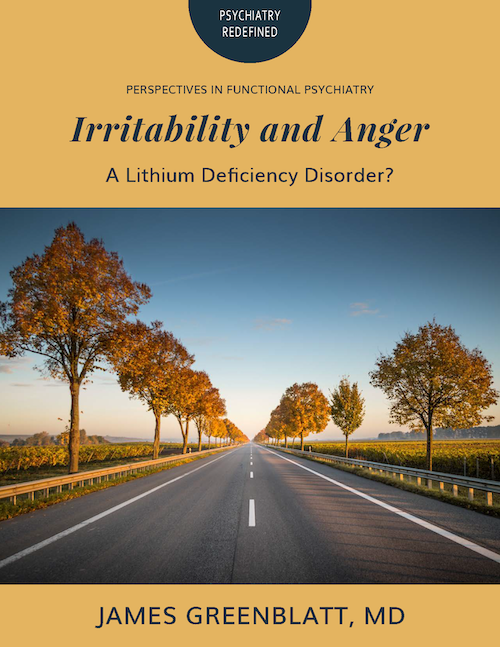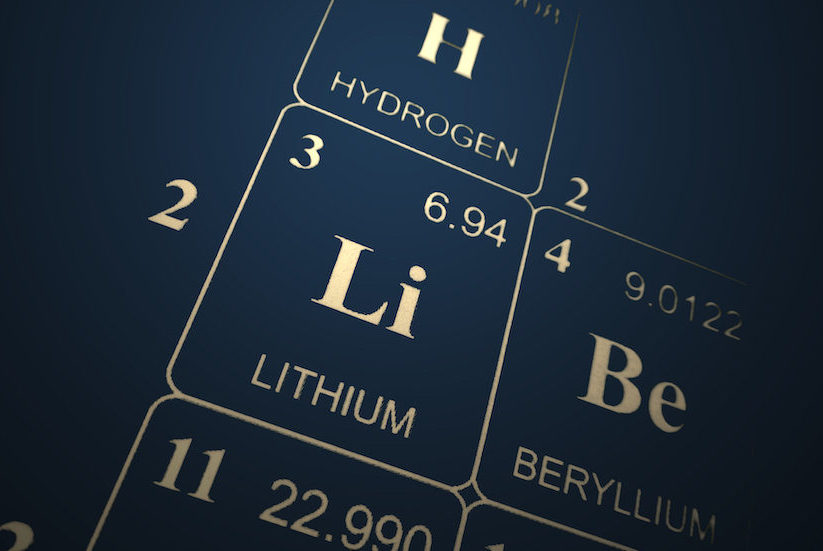Discover a mineral essential to human health
Present in trace amounts in the foods we eat and the water we drink, lithium is a critical nutrient for many aspects of human physiology. While it has been widely prescribed and researched as a mood stabilizing drug, it continues to be one of the most slandered and misunderstood therapies in medicine. Lithium can be used in low doses mimicking those found in our food and water to balance brain chemistry safely and effectively.
About Lithium
One of The Original Earth Elements
As far as cosmologists know, there were only three elements present when the universe was first formed some 13.8 billion years ago: hydrogen, helium and lithium. As one of the three original elements, lithium can still be found in plenty throughout our atmosphere. Meteorites, the sun and stars burn brightly with the flame of this highly reactive element. Here on earth, lithium remains a major mineral component of granite rock, and also lingers in significant amounts in sea water, mineral springs and soils. Every organ and tissue in the human body also contains the mineral lithium.
Lithium was given its official name by a chemist named Johan August Arfvedson in 1817. He found the element when researching petalite – a rich mineral deposit found in soils- on a remote Swedish island. The metal was aptly named lithium, a term derived from the Greek word lithos meaning literally “from stone.” Subsequent research has given scientists a greater appreciation of this alkali earth metal, which is now known to be relatively common in the Earth’s upper crust. As the 27th most abundant element it can be found in rock sediments, salt flats and mineral springs at varying concentrations throughout the globe. The largest deposits of lithium are salars or vast saline basins in the deserts of South America. But the mineral is also highly concentrated in clay beds and hard rock underground mines dotting Australia, China and some parts of North America.
As the lightest of all solid elements, lithium is highly reactive, malleable, and also a good conductor of heat and electricity. These characteristics have contributed to its wide applications in industry today, such as in the development of technologies like batteries and devices for telecommunication, aircraft parts, focal lenses and even the fusion material in power plants. The demand for lithium-ion batteries as a durable power source for camcorders, cameras, cell phones, portable computers and eco-friendly vehicles has caused lithium commodity prices to rise in recent years, creating speculation as to whether sufficient volumes of lithium are even available to sustain global demand. This will become an increasingly important issue for us to consider in research and practice, as over-mining and environmental contamination threaten stores of lithium in certain regions around the globe.
Learn More
- “Lithium 101” (video by National Geographic)
- “Lithium Ion Batteries are everywhere. Their creators just won the Nobel Prize” (article by VOX)
- “South America’s Lithium Boom” (video)
- Lithium Statistics and Information (US Geological Survey National Minerals Information Center)
Lithium in Medicine
History of Medical Use
The healing properties of lithium have been recognized for centuries.
A physician from ancient Ephesus observed its benefits but did not know its name. When asked how to treat people undergoing manic episodes, he responded, “Utendum quoque naturalibus aquis, ut sunt nitrosae,” meaning,”Use should be made of natural waters, such as alkaline springs.” Lithium, it turned out, was present in abundance in these springs.
Since this observation from ancient times, lithium has undergone a shifting and dramatic history in medicine, sometimes celebrated as a panacea, sometimes reviled as toxic, sometimes totally forgotten before reappearing in scientific experiments in another country in another context. Still, after the intervening centuries and billion dollar pharmaceutical breakthroughs, no drug has superseded lithium for stabilizing mood and preventing suicide in patients with bipolar disorder.
Soranus from Ephesus was followed by centuries of silence on the issue. Almost 2000 years later, the treatment benefits of lithium were publicized by London doctor Alfred Baring Garrod, who used it to treat patients with gout. After discovering uric acid in the blood of his patients with gout, he wrote about pioneering the use of lithium in his 1859 treatise, The Nature and Treatment of Gout and Rheumatic Gout. He explained that uric acid deposits in cartilage are dissolved in vitro by carbonate lithium. Between the 1850’s and the 1890’s, several other physicians experimented with lithium treatment because at the time uric acid was viewed as a critical factor in many diseases.
Both the popular and medical literature of the period contain enthusiastic reports of the benefits of lithia waters. For example, Manadnock Lithia Spring Water was touted as “the most wonderful natural lithia spring water now known in the world. Recommended for gout, dyspepsia, rheumatism, eczema, sugar diabetes, Bright’s disease, gall stones; also reduces temperature in all fevers; and all disease of the kidneys, asthma, etc. As a beautifier of the complexion it has no equal” (Strobusch, AD, Jefferson, JW, 73).
Soon after this rave review, public enthusiasm for alkaline springs fizzled. A study by the U.S. Bureau of Chemistry had found that all the lithia waters on the American market contained only infinitesimal traces, or less than one part per million, of lithium, not nearly enough to bring about the cures for which they were advertised. So the lithia springs as a treatment for disease fell out of favor.
As lithia springs faded from the news, lithium tablets appeared on the market. For several decades tablets and other products containing lithium were recommended for treating kidney and bladder problems as well as gallstones. The Sears, Roebuck & Company Catalogue of 1908 advertised Schieffelin’s Effervescent Lithia Tablets for a variety of uric acid afflictions. By 1907, The Merck Index listed 43 different medicinal preparations containing lithium. In 1929, a soft drink inventor named Charles Leiper Grigg even created a new lithiated beverage he called Bib-Label Lithiated Lemon-Lime Soda, now known as “7-Up.” The beverage contained lithium citrate until 1950, and was originally known and marketed for its potential to cure hang-overs after a night of drinking alcohol, and to lift mood. In the 1930’s, the varied products containing lithium on the market were advertised to control renal calculi and uric acid problems. In 1939, the German pharmaceutical index, The Red List, featured “Lithosanal Bauer,” a combination of lithium citrate and other components for the purposes of treating kidney and bladder problems and gallstones.
Meanwhile, toward the end of the 1800’s, some American physicians were investigating possible psychiatric benefits of lithium. In 1870, Philadelphia neurologist Silas Weir Mitchell recommended lithium bromide as an anticonvulsant and a hypnotic. William Hammond, professor of diseases of the mind and nervous system at the Bellevue Hospital Medical College in New York, was the first physician to prescribe lithium for mania. He found it more effective than any other treatment he had ever used for calming mood in his patients with manic episodes.
A significant twentieth century revival of lithium as a possible psychiatric remedy began in 1949 in Melbourne, Australia, when John Cade, who knew of Garrod’s success in lithium treatment a century before, speculated that a condition involving uric acid might underlie his patients’ mania. He began treating patients with lithium citrate and lithium carbonate. Some patients responded strikingly well, even after years of illness and unsuccessful treatment with other preparations. Although it was published in an obscure journal, Cade’s article described a well-designed and executed research study and focused on rational presentation of results rather than rhapsodizing about the virtues of a particular treatment. The benefits that lithium conferred to patients with mania were dramatic. Because of his well-structured study and the dramatic results, some historians of medicine consider that John Cade ushered in modern psychopharmacology.
Unfortunately, the timing of Cade’s treatment successes was ill-fated. The very same year, 1949, adverse reaction reports surfaced in the media about patients who were taking lithium in a different form for a completely different purpose. As physicians encouraged their patients with heart disease and hypertension to avoid sodium chloride, lithium chloride was marketed as an alternative to sodium chloride in four different preparations: Salti-salt, Milosal, Foodsal, and Westsal. In the late 1940’s and early 1950s, physicians around the country released reports of patients who developed lithium poisoning after they had used Westsal. Dr. A.M. Waldron documented that four of his patients who used Westsal developed weakness and blurred vision. The next year, Dr. John H. Talbott collected and released case studies of his patients who suffered lithium poisoning. Excessive intake of lithium coupled with the tendency of the body to retain more lithium when sodium intake was low led to disastrous results. Several deaths were also reported, leading the FDA to ban the use of lithium salt substitutes. “Stop using this dangerous poisoning at once!” exhorted the FDA. Lithium fell out of favor with the medical community.
Despite the lithium chloride debacle, Cade’s study prompted a few isolated studies of lithium in Australia and in France. Cade himself left lithium research behind and began to explore the psychotropic effects of other alkali metals in his lab in Australia.
Yet by the end of the decade a “lithium underground” had formed of American physicians prescribing lithium in the absence of official FDA approval. Finally, the FDA approved lithium in 1970 as a new investigational drug for use in treatment of acute mania. By this time many other countries had already approved lithium, including France, the United Kingdom, Germany, and Italy. In 1974, lithium was approved to prevent recurrent mania.
What will be the next chapter in the dramatic and shifting history of lithium? It seems paradoxical that this simple substance, the third element in the Periodic Table, still achieves better treatment results in bipolar patients than the new and expensive products of pharmaceutical research and development. If lithium as treatment once again fades from view, the loss will not be to the pharmaceutical companies which, after all, have nothing to gain from the success of a low-cost treatment. Those who will lose are the patients whose uncomfortable highs and lows and suicidal impulses could be better kept in check by psychiatry’s best and oldest drug.
The Primary Sources of Lithium
Grains, Vegetables & Tap Water
Because lithium is abundantly present in rocks and soils, the mineral is also found in significant amounts in our food and water supplies. The U.S. Environmental Protection Agency has estimated that the daily lithium intake of an average adult ranges from about 0.65 mg to 3 mg. Grains and vegetables serve as the primary sources of lithium in a standard diet, with animal byproducts like egg and milk providing the rest. Lithium has even been officially added to the World Health Organization’s list of possible nutritionally essential trace elements, in a report covering zinc, iodine and others.
The most frequent source of lithium in the modern diet however is tap water. Depending on geographical location, drinking water can be quite potent in naturally occurring lithium. According to environmental surveys, water with high mineral content content can translate to 2 mg or so of lithium per day. A series of fascinating ecological studies has found that communities with higher levels of lithium in the water,have lower overall rates of psychiatric illness, suicide and violent crime. 1
Due to the lack of attention attributed to lithium as a food source by the FDA and other dietetic associations, there is little research on the specific consequences of lithium deficiency in humans. However, trials in which animals have been put on low lithium diets have revealed a gross decrease in reproductive function, life span and lipid metabolism as a result. It is quite possible that the effects of lithium deficiency amidst humans are widespread, yet under-recognized as such and mistaken for other medical phenomena. 2
Lithium as a Therapy
Research shows that low-dose lithium promotes healing in the brain.
Today we tend to think of lithium almost exclusively as a high-dose mood stabilizing drug. While it is clearly one of the best medications for treating bipolar disorder, many psychiatrists have been hesitant to prescribe it because it can be toxic at high, or pharmaceutical, doses. Concern about side effects and toxicity evaporate however, when lithium is used at a nutritional, or low doses.
It is important to remember that lithium is a naturally-occurring mineral and nutrient. It can be used in low doses mimicking those found in our food and water supplies to balance brain chemistry safely and effectively. According to the latest scientific research, attributes of low-dose lithium supplementation have included emotional balance, positive mood, tolerance of negative mood, behavioral support, decreased aggression and impulsivity and increased neurocognitive health including memory, cognition and longevity. Although additional studies are essential to deepen our understanding of the clinical applications of this mineral, the preliminary collection is encouraging.
A series of studies on the levels of lithium in drinking water have contributed to the understanding of how low-dose lithium may ameliorate aggression. In the initial study, the levels of lithium in the water of 27 Texan counties was analyzed and compared to the rates of crime and suicide over a 9 year span. Researchers found that the incidence of suicide, homicide, and rape were significantly higher in counties with drinking water containing little or no lithium, versus those with levels ranging from 70-170 mcg/L. (1) This study template has been applied and repeated international at sites in Japan, Austria and England. The collection has revealed strong trends of a negative correlation between violent, aggressive crime and supplemental levels of lithium in the water supply.
Another interesting finding came from a study that looked at lithium levels in the hair of criminals. Hair analysis is one of the most accurate methods for testing long-term mineral status and is therefore highly advantageous for determining where deficiencies are present. This study found that violent criminals had little to no stores of lithium when tested via hair mineral analysis, bringing forth the idea that perhaps lithium deficiency was contributing to defiant behaviors. More recent research has shown that a daily dose of 400 mcg of lithium in participants with histories of aggression and impulsivity had significant impact on happiness, friendliness, and other mood-related parameters. (2)
In anther study, a microdose of 300 mcg lithium was administered to Alzheimer’s patients for 15 months. When compared to the control, it was observed that there were significant improvements in cognitive markers in the group using low-dose lithium after just 3 months of treatment. These protective effects were strengthened as the study proceeded, suggesting that lithium could be used as a successful treatment for Alzheimer’s Disease at low doses over the long term. (3)
Read More
Low-Dose Lithium Impact in An Addiction Treatment Setting
By Sudhir Gadh, MD, Sept. 2020
Lithium: A Doctor, A Drug, and A Breakthrough
by Walter A. Brown, August 2019
Is There a Role for Lithium Orotate in Psychiatry?
by Peter Devadason, November 2018
Low-Dose Lithium: A Review of Why It’s Good For Us (PDF download)
by Jonathan Wright, MD, Green Medicine Newsletter
Prevent Adverse Lithium Effects with Essential Fatty Acids (PDF download)
by Jonathan Wright, MD, Green Medicine Newsletter
Alzheimer’s & Cognitive Decline
As many as 10% of healthy 50-year-olds have amyloid deposits – the deposits that block neuronal synapses in Alzheimer’s disease.
Articles by Dr. James Greenblatt
Peer-Reviewed Studies
- Proposed Prophylactic use of Lithium to improve Cognitive Decline and Mental Health in Disorders such as Alzheimerʼs Disease and Depression
-
Lithium and risk for Alzheimer’s disease in elderly patients with bipolar disorder
Potential Mechanisms & Pathways of Lithium for Alzheimer’s disease
Dr. Greenblatt’s integrative psychiatric model focuses efforts in the preventative and modifying phases of disease progression. Peer-reviewed studies suggest potential mechanisms and pathways by which lithium may address Alzheimer’s disease (partial list):
- Increases grey matter
- Inhibits Glycogen Synthase Kinase-3 (GSK-3), thereby potentially slowing the production of amyloid and tau proteins
- Lowers amyloid-B levels
- Prevents hyperphosphorylation of tau protein: rescue tau-induced impairments of learning and attenuate the emergence of histopathological changes
- Prevents neuronal destruction. lithium ions support the expression of anti-apoptotic molecules
- Regulates glutamate. prevents the uptake of glutamate into the cells by deactivating N-methyl-D-aspartate (NMDA) receptors (NMDAR), the main class of glutamate receptors in the nervous tissue
- Upregulates Bcl-2. Increases bc1-2 in the frontal cortex, hippocampus and striatum (animal model); and human neurons
- Restores protein homeostasis. Microdose lithium exerted statistically significant positive outcomes in human studies Alzheimer’s patients and animal models of the disease
- Epigenetic modulation. Reduces methylation on lysine 27 on histone H3 – one of the chromatin marks found to be altered in patients with Alzheimer’s disease
Suicide Prevention
Peer-reviewed studies report that naturally occurring lithium in drinking water associates with lower suicide rates.
Peer-Reviewed Studies
- Lithium in drinking water linked with lower suicide rates.
- Lithium in drinking water and suicide prevention: The largest epidemiological study from Japan.
- Association between naturally occurring lithium in drinking water and suicide rates: systematic review and meta-analysis of ecological studies.
- Relationship between Lithium Levels in Drinking Water and Suicide Rates: A Nationwide Study in Lithuania.
- Lithium and suicide prevention in mood disorders and in the general population: A systematic review.
- Relationship between suicide mortality and lithium in drinking water: A systematic review and meta-analysis.
COVID-19
Lithium inhibits glycogen synthase kinase 3-beta (GSK-3β), as well as GSK-3α, inositol monophosphatases, and may indirectly act via the electrolyte balance. As such, there is interest in the potential utilization of lithium for COVID-19 (SARS-CoV-2 infection).
Peer-Reviewed Studies
- Substance use disorders linked to COVID-19 susceptibility. Learn more about COVID-19 susceptibility on the NIH website.
- Three-times greater prevalence of depression symptoms among Americans during COVID-19 pandemic.
- Coping with the Collision of Public Health Crises: COVID-19 and Substance Use Disorders (NIH Director’s blog)
- Microdose lithium reduces cellular senescence in human astrocytes – a potential pharmacotherapy for COVID-19?
- Lithium as a candidate treatment for COVID-19: Promises and pitfalls.
- Lithium’s antiviral effects: a potential drug for CoViD-19 disease?
Educational Courses on Lithium
Low-Dose Nutritional Lithium Course
Learn how to safely utilize low-dose nutritional lithium for a range of mental health disorders.
Functional Medicine for Cognitive Decline & Alzheimer’s Course
Discover a functional medicine approach for the treatment of Alzheimer’s and cognitive decline.
Protocols for Preventing Cognitive Decline & Dementia
Learn how low dose lithium can improve mental health and heal the brain in this webinar.
Books About Lithium

Nutritional Lithium: A Cinderella Story
The Untold Story of the Mineral That Transforms Lives and Heals the Brain
By James Greenblatt, MD
Lithium has been widely prescribed and researched as a mood stabilizing drug, yet it continues to be one of the most slandered and misunderstood therapies in medicine. Rather, it is a mineral that is essential to human health. Present in trace amounts in the foods we eat and the water we drink, lithium is a critical nutrient for many aspects of human physiology. There is an abundance of research on lithium as a healing supplement for a variety of ailments including mood disorders, behavioral issues and cognitive decline. This book provides a review of these fascinating studies, coupled with clinical evidence of the benefits of low-dose lithium therapy.

Integrative Medicine for Alzheimer’s:
The Breakthrough Natural Treatment Plan That Prevents Alzheimer’s Using Nutritional Lithium
By James Greenblatt, MD
- Summary of Alzheimer’s research and current treatments
- Explanation of integrative medicine
- Scientific research showing effects of lithium on Alzheimer’s patients
- Summary of treatment and prevention of Alzheimer’s using lithium

Nutritional Lithium Ebook – FREE!
Irritability & Anger: A Lithium Deficiency Disorder?
By James Greenblatt, MD
Are your patients struggling with anger? Are you ready to move beyond symptom management, and help them find lasting wellness? Learn more about treating aggression and irritability with nutritional lithium in our free ebook.
Supplements
(Online Dispensary)
Access over 300 practitioner-grade brands of high-quality supplements, with secure HIPAA- and PCI-compliant ordering.
Get started here.
The information on this website is not intended to prevent, diagnose, treat, or cure disease or illness. Prior to commencing or changing any health regimen, you must consult a qualified healthcare professional. Lithium is not medically advisable for those who are pregnant, trying to become pregnant, or nursing.





